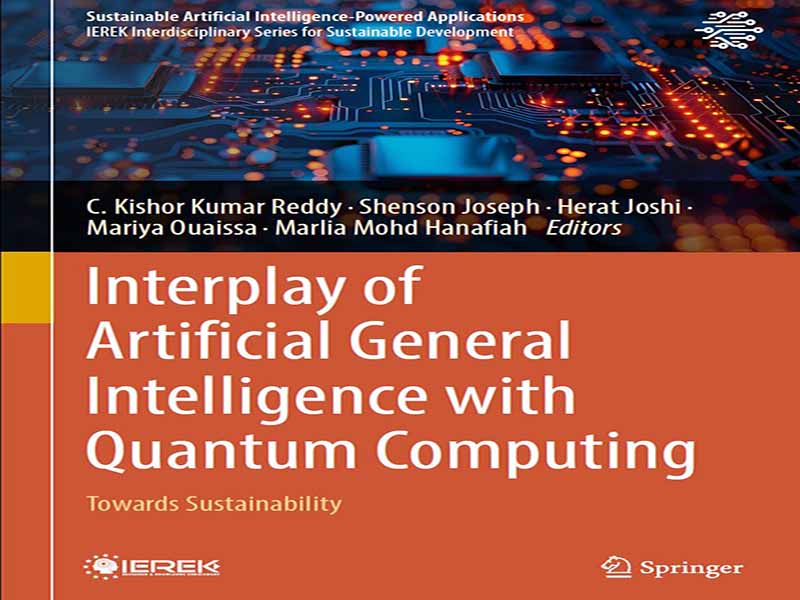- عنوان کتاب: Interplay of Artificial General Intelligence with Quantum Computing Towards Sustainability
- نویسنده: C. Kishor Kumar Reddy, Shenson Joseph
- حوزه: محاسبات کوانتومی
- سال انتشار: 2025
- تعداد صفحه: 280
- زبان اصلی: انگلیسی
- نوع فایل: pdf
- حجم فایل: 7.05 مگابایت
کتاب پیشنهادی «تعامل هوش عمومی مصنوعی با محاسبات کوانتومی» به بررسی تقاطع پیشگامانه هوش عمومی مصنوعی (AGI) و محاسبات کوانتومی میپردازد. این کتاب بررسی میکند که چگونه AGI، که هدف آن تکثیر تواناییهای شناختی شبه انسانی است، میتواند توسط قابلیتهای پردازش منحصر به فرد محاسبات کوانتومی ارتقا یابد. این کتاب به مبانی نظری، کاربردهای عملی و همافزاییهای بالقوه میپردازد و نشان میدهد که چگونه محاسبات کوانتومی میتواند با چالشهای محاسباتی پیچیده ذاتی در توسعه AGI مقابله کند. این کتاب با ادغام این فناوریهای پیشرفته، تجزیه و تحلیل جامعی از تأثیر ترکیبی آنها ارائه میدهد و بینشهایی در مورد پیشرفتهای آینده و پتانسیل تحولآفرین ادغام AGI با محاسبات کوانتومی ارائه میدهد.
فصل «شکلدهی به فردا: همگرایی هوش عمومی مصنوعی و محاسبات کوانتومی» به بررسی پیشرفتهای سریع در هوش مصنوعی (AI) و محاسبات کوانتومی میپردازد که مرزهای نوآوری فناوری را از نو تعریف میکنند. از آنجایی که هوش عمومی مصنوعی (AGI) تلاش میکند تا تواناییهای شناختی شبه انسانی را تکثیر کند و محاسبات کوانتومی قدرت محاسباتی را متحول میکند، همگرایی آنها نویدبخش امکانات بیسابقهای برای علم، صنعت و جامعه است. این اثر، پتانسیل دگرگونکنندهی این فناوریها را بررسی میکند و به همافزاییها، پیامدهای اخلاقی و مسیرهای آیندهی آنها میپردازد. هدف آن ارائهی درکی جامع از چگونگی همکاری هوش مصنوعی عمومی و محاسبات کوانتومی، برای شکلدهی آیندهای با نوآوری، مسئولیتپذیری و تغییر عمیق است.
فصل «تکامل هوش مصنوعی و محاسبات کوانتومی» به تکامل هوش مصنوعی و محاسبات کوانتومی میپردازد و پیشرفتهای بنیادی و نقاط عطف دگرگونکنندهی آنها را دنبال میکند. این فصل، سفر هوش مصنوعی را از خاستگاههای فلسفی تا کاربردهای مدرن آن در شبکههای عصبی و مدلهای تولیدی برجسته میکند. محاسبات کوانتومی از طریق پیشرفتهای نظری و پیشرفتهای عملی آن، مانند برتری کوانتومی و الگوریتمهای بهینهسازی، بررسی میشود. همافزایی بین هوش مصنوعی و محاسبات کوانتومی مورد تأکید قرار میگیرد و پتانسیل ترکیبی آنها برای ایجاد انقلابی در صنایعی مانند مراقبتهای بهداشتی، مالی و مدلسازی آب و هوا به نمایش گذاشته میشود. چالشهای کلیدی، از جمله مقیاسپذیری، تصحیح خطا و نگرانیهای اخلاقی، مورد بررسی قرار میگیرند. این روایت با نگاهی آیندهنگر به ادغام آنها پایان مییابد و آیندهای از نوآوری مسئولانه و تأثیرگذار را پیشبینی میکند. فصل «معماری شبکههای عصبی کوانتومی: طراحی و پیادهسازی» بر معماری شبکههای عصبی کوانتومی (QNN) تمرکز دارد و کاوشی عمیق در طراحی، پارامترها و عناصر بنیادی آنها ارائه میدهد. این فصل مدارهای کوانتومی، گیتهای کوانتومی پارامتری و نقشههای ویژگی کوانتومی را که جزئی جداییناپذیر از ساخت QNNها هستند، بررسی میکند. همچنین مروری بر الگوریتمهای کوانتومی متغیر ارائه میدهد و نقش آنها را در توانمندسازی یادگیری و بهینهسازی کارآمد در سیستمهای کوانتومی برجسته میکند. ملاحظات عملی برای پیادهسازی QNNها بر روی دستگاههای کوانتومی مقیاس متوسط نویزدار (NISQ) در کنار استراتژیهایی برای پرداختن به محدودیتهای سختافزاری و تابآوری در برابر نویز مورد بحث قرار گرفته است. این فصل با ترکیب بینشهای نظری با کاربردهای عملی، پایه و اساس جامعی برای درک و پیشرفت QNNها در زمینه یادگیری ماشین کوانتومی ارائه میدهد.
فصل «همگرایی محاسبات مبتنی بر کوانتومی و یادگیری ماشین: هموار کردن مسیر هوش عمومی مصنوعی» بر ادغام محاسبات کوانتومی و یادگیری ماشین برای پیشبرد هوش عمومی مصنوعی (AGI) از طریق یادگیری ماشین کوانتومی (QML) تمرکز دارد. این فصل، مبانی نظری QML، از جمله حالتهای کوانتومی، دروازهها و الگوریتمهایی مانند PCA کوانتومی را بررسی میکند. این فصل، پتانسیل QML را در حل وظایف پیچیده با سرعت، مقیاسپذیری و دقت بهبود یافته، به ویژه در حوزههایی مانند رباتیک، بهینهسازی و پردازش زبان طبیعی، برجسته میکند. چالشهای فنی مانند نویز و نمایش دادهها با راهحلهایی برای غلبه بر آنها مورد بررسی قرار میگیرد. روندهای نوظهور و چشماندازهای آینده QML در AGI، در کنار پیامدهای اخلاقی و مسائل مربوط به حاکمیت، مورد بحث قرار میگیرند. از طریق این کاوش، خوانندگان درک خواهند کرد که چگونه QML قرار است سیستمهای اطلاعاتی را متحول کند و AGI را به جلو سوق دهد.
فصل “همافزایی محاسبات کوانتومی و یادگیری ماشین برای هوش عمومی مصنوعی برتر” ترکیبی از محاسبات کوانتومی و یادگیری ماشین است و قرار است در سالهای آینده انقلابی در بخش هوش مصنوعی ایجاد کند. این فصل به همافزایی امیدوارکننده بین این حوزههای قدرتمند و چگونگی پیشرفت آنها در سرعت توسعه هوش عمومی مصنوعی (AGI) میپردازد. AGI با ارائه چارچوب ساختاری برای یادگیری و رشد تدریجی سیستمهای کوانتومی، پتانسیل آنها را افزایش میدهد. علیرغم چالشهای فعلی از نظر محدودیتهای سختافزاری، الزامات مقیاسپذیری الگوریتمها – ادغام قریبالوقوع این فناوریها …
The proposed book Interplay of Artificial General Intelligence with Quantum Computing exam-ines the groundbreaking intersection of Artificial General Intelligence (AGI) and quantum computing. The book explores how AGI, which aims to replicate human-like cognitive abil-ities, can be enhanced by quantum computing’s unique processing capabilities. It delves into theoretical foundations, practical applications, and potential synergies, illustrating how quantum computing could tackle complex computational challenges inherent in AGI development. By integrating these advanced technologies, the book provides a comprehensive analysis of their combined impact, offering insights into future advancements and the transformative potential of merging AGI with quantum computing.
Chapter “Shaping Tomorrow: The Convergence of Artificial General Intelligence and Quantum Computing” explores the rapid advancements in Artificial Intelligence (AI) and quantum computing, which are redefining the boundaries of technological innovation. As Arti-ficial General Intelligence (AGI) strives to replicate human-like cognitive abilities, and quantum computing revolutionizes computational power, their convergence promises unprecedented possibilities for science, industry, and society. This work explores the transformative potential of these technologies, delving into their synergies, ethical implications, and future trajectories. It aims to provide a comprehensive understanding of how AGI and quantum computing, together, can shape a future marked by innovation, responsibility, and profound change.
Chapter “Evolution of Artificial Intelligence and Quantum Computing” delves into the evolu-tion of AI and quantum computing, tracing their foundational developments and transformative milestones. It highlights AI’s journey from philosophical origins to its modern applications in neural networks and generative models. Quantum computing is explored through its theoret-ical breakthroughs and practical advancements, such as quantum supremacy and optimization algorithms. The synergy between AI and quantum computing is emphasized, showcasing their combined potential to revolutionize industries like healthcare, finance, and climate modeling. Key challenges, including scalability, error correction, and ethical concerns, are addressed. The narrative concludes with a forward-looking perspective on their integration, envisioning a future of responsible and impactful innovation.
Chapter “Architecture of Quantum Neural Networks: Design and Implementation” focuses on the architecture of Quantum Neural Networks (QNNs), providing an in-depth exploration of their design, parameters, and foundational elements. The chapter examines quantum circuits, parameterized quantum gates, and quantum feature maps, which are integral to the construction of QNNs. It also offers an overview of variational quantum algorithms, highlighting their role in enabling efficient learning and optimization on quantum systems. Practical considerations for implementing QNNs on Noisy Intermediate-Scale Quantum (NISQ) devices are discussed, alongside strategies to address hardware constraints and noise resilience. By combining theo-retical insights with practical applications, this chapter provides a comprehensive foundation for understanding and advancing QNNs in the field of quantum machine learning.
Chapter “Quantum-Based Computing and Machine Learning Convergence: Paving the Path to Artificial General Intelligence” focuses on the integration of quantum computing and machine learning to advance Artificial General Intelligence (AGI) through Quantum Machine Learning (QML). It explores the theoretical foundations of QML, including quantum states, gates, and algorithms like quantum PCA. The chapter highlights QML’s potential in solving complex tasks with improved speed, scalability, and precision, particularly in areas like robotics, optimization, and natural language processing. Technical challenges such as noise and data representation are addressed with solutions for overcoming them. Emerging trends and future prospects of QML in AGI are discussed, alongside ethical implications and governance issues. Through this exploration, readers will understand how QML is set to transform intelligence systems and drive AGI forward.
Chapter “Synergizing Quantum Computing and Machine Learning for Superior Artificial General Intelligence” is the combination of quantum computing and machine learning, and it is destined to revolutionize the AI sector in the years to come. This chapter elaborates on a promising synergy between these powerful domains and how they might together advance the rate of artificial general intelligence (AGI) development. AGI enhances the potential of quantum systems by providing the structural framework for them to learn and grow progressively. Despite current challenges in terms of hardware limitations, scalability requirements of algorithms— the impending merging of these technologies is bound to bring about breakthroughs in AGI. This chapter analyzes the major ethical boundaries and trends that make the relation between quantum computing and ML in the context of improving AGI even more interesting.
Chapter “Deep Dive into Generative, Federative and Explainable Models for Integrating Artificial General Intelligence into Quantum Computing” focuses on various technologies merging artificial general intelligence into quantum computing. Various generative, federa-tive, and explainable models are explained, which include the general architecture and promi-nent features. Some of the models that are discussed in the article in relation to quantum machine learning include Quantum Neural Networks (QNNs), Quantum Convolutional Neural Networks (QCNNs), and Quantum Generative Adversarial Networks (QGANs). Such models extend the possibilities of quantum mechanics beyond what is perceived to be capable with artificial intelligence, bringing an extensive improvement in data processing, optimization, and generation.
Chapter “AGI: A Transformational Paradigm: Comprehension and Navigation of Future Intelligence” proceeds with the foundational concepts of AGI, its evolution, and its far-reaching implications across industries and societies. Through a more technical exploration of break-throughs in technology, ethics, and societal effects, this chapter creates a holistic vision of how all these things train AGI, which then has the ability to redefine human interaction with machines. The chapter goes beyond this and talks about the potential of AGI to solve global challenges-such as that of climate change and poverty-while also underlining risks such as ethical dilemmas and existential threats. Therefore, the chapter focuses on developing AGI within an appropriate regulatory scheme and for the benefit of mankind. This also calls the entire researching, policy-making, and industrial parts for cooperation in the journey of the AGI journey, since it is an evolving field prone to several benefits and risks associated with it.
Chapter “Enhancing Metaheuristics: The Role of Quantum-Inspired Soft Computing” explores the advancements and applications of quantum-inspired soft computing techniques, emphasizing their role in enhancing metaheuristic algorithms. By merging quantum mechanics with optimization methodologies, these techniques address complex real-world challenges, from engineering design to network optimization. Highlighting recent developments, the work categorizes algorithms into biologically inspired, nature-based, and human-based approaches while examining their merits and limitations. It also presents future research directions, including real quantum computer integration, parameter optimization, and scalability. This comprehensive study aims to guide researchers and practitioners in leveraging quantum-inspired algorithms for innovative solutions across various domains.
Chapter “Quantum Algorithms for AGI: Unlocking the Potential of Superintelligence” explores the convergence of quantum computing and Artificial General Intelligence (AGI), focusing on their transformative potential. AGI aims to create machines capable of human-like cognitive functions, while quantum computing harnesses the power of quantum mechanics to solve complex problems faster. By combining these fields, new possibilities emerge for tack-ling challenges beyond the reach of classical computing. Quantum algorithms can significantly enhance AGI systems, particularly in areas like optimization, decision-making, and learning. The synergy between AGI and quantum computing promises breakthroughs across various domains, including healthcare, robotics, and climate prediction.
In Chap. “Ethical AI Development: Mitigating Bias in Generative Models”, delve deeper into the complexities of bias in generative AI, building on earlier discussions to underscore the need for robust detection and mitigation strategies. This chapter synthesizes current research on fairness, inclusivity, and ethical deployment of AI by exploring advanced methods such as adversarial testing, statistical analysis, and open-set bias detection. We also highlight the efficacy of data-centric remedies, including augmentation and resampling, coupled with fairness-aware constraints and post-processing adjustments like equalized odds. However, as the research abstract below reveals, these interventions are not without limitations, ranging from data diver-sity challenges to the evolving nature of bias in high-stakes contexts like health care and law enforcement. By unpacking these issues and proposing directions for future inquiry, Chap. “Ethical AI Development: Mitigating Bias in Generative Models” emphasizes the imperative for continuous monitoring, intersectional analysis, and broader stakeholder engagement to ensure generative AI systems are equitable, ethical, and socially responsible.
Chapter “Future Frontiers: The Role of AGI and Quantum Computing in Solving Complex Global Problems” explores the powerful synergy between Artificial General Intelligence (AGI) and quantum computing, two technologies that are poised to revolutionize our approach to solving complex global challenges. By combining AGI’s human-like cognitive abilities with the unparalleled computational power of quantum systems, we can tackle issues such as climate change, healthcare, energy sustainability, and global security more effectively than ever before. The chapter delves into how these technologies complement each other, enhancing decision-making processes and enabling more efficient problem-solving. Through a comprehensive examination of real-world applications, experimental results, and future trends, we demon-strate how AGI and quantum computing will shape industries and drive innovation. Ultimately, this convergence represents a transformative opportunity to address some of humanity’s most pressing problems and unlock new potential for global progress.
Chapter “Toward Autonomous Quantum Systems: AGI-Driven Self-Optimization and Quantum Computing Synergy” explores the groundbreaking potential of combining Artifi-cial General Intelligence (AGI) with quantum computing to address key challenges in quantum systems, particularly in error correction and self-optimization. With the rapid advancements in quantum computing, systems face significant barriers such as quantum decoherence, noise, and high error rates, which hinder their scalability and reliability. By integrating AGI’s self-learning and adaptive capabilities, quantum systems can autonomously optimize performance, manage errors, and improve computational efficiency. This synergy promises a paradigm shift in quantum computing, enabling real-time decision-making and fault tolerance essential for tack-ling real-world problems in fields like cryptography, material science, and machine learning. Through this chapter, we present methodologies, experimental results, and future directions that demonstrate how AGI-driven quantum systems can shape the future of autonomous quantum computing.
Chapter “Quantum Machine Learning for AGI: Redefining Intelligence Through Quantum Algorithms” delves into the profound implications of “Quantum Machine Learn-ing” in the evolution of AGI. It explores fundamental ideas, including data encoding, opti-mization algorithms, and hybrid quantum-classical models, examining their significance in addressing intricate challenges across various sectors. This chapter explores advanced tech-niques and applications, emphasizing the interplay between foundational technology, such as quantum computing, and conventional methods to foster innovation. This chapter offers a thorough exploration of quantum machine learning in the context of AGI, highlighting its importance within the broader landscape of artificial general intelligence development through practical insights and forward-thinking perspectives. Chapter “Quantum-Enhanced Artificial General Intelligence: Bridging Computational Paradigms” explores the transformative potential of integrating quantum computing with Arti-ficial General Intelligence (AGI) to overcome the limitations of traditional computing systems. While AI has made significant strides in fields like machine learning, its capabilities are constrained by the power of classical computing systems. Quantum computing, with its prin-ciples of superposition, entanglement, and parallelism, offers a new frontier in computational power, enabling AGI to tackle highly complex problems at an unprecedented scale. By merging these two technologies, we open the door to groundbreaking advancements in areas such as healthcare, cybersecurity, and climate change. This chapter delves into the synergy between quantum computing and AGI, presenting a vision for a future where intelligent systems can evolve, learn, and solve problems in ways that were once beyond our reach.
Chapter “Quantum-Infused Deep Learning Frameworks Utilizing Quantum-Enhanced Feature Extraction to Propel AGI” focuses on Quantum Distributed Deep Learning (QDDL), a cutting-edge framework that seamlessly integrates distributed deep learning architectures with the computational capabilities of quantum mechanics. By leveraging quantum phenomena such as superposition and entanglement within hybrid quantum-classical systems, QDDL signif-icantly enhances feature extraction, dimensionality reduction, and optimization processes. This chapter highlights the framework’s robustness in noisy environments and its ability to scale effectively, making it highly applicable to real-world scenarios in advancing Artificial General Intelligence (AGI). QDDL’s transformative potential in redefining intelligent systems establishes it as a cornerstone for future research and applications in artificial intelligence.
Chapter “Streamflow Forecasting in the Downstream Catchment of Mahanadi River Basin Using AI and Quantum Computing” addresses the challenge of flood prediction by focusing on the Mahanadi River Basin, one of India’s most flood-prone regions. Leveraging 42 years of historical data from key rain gauge stations—Kantamal, Kesinga, Salebhata, and Tikarpara— presents a learning-based approach to forecasting flood events. Tikarpara, situated downstream, plays a pivotal role in this study as a target station for discharge predictions based on upstream data. The proposed quantum-based BiLSTM model emerged as the most effective tool, demon-strating superior accuracy in forecasting discharge levels and outperforming other methods. Its ability to deliver lower RMSE and MAE values highlights its potential as a robust solution for streamflow prediction and water management in the Mahanadi River Basin. This chapter represents a step forward in addressing the challenges of flood prediction, combining decades of historical data with cutting-edge AI and quantum-based models. We hope this work contributes to enhancing resilience against flooding events and inspires further advancements in predictive analytics for disaster management.
Chapter “Integrating Neural Networks with Quantum Chips: Converging Two Cutting-Edge Frontiers” explains the transformative potential of blending neural networks with quantum computing to tackle complex problems beyond the reach of classical systems. It explores how quantum principles like superposition and entanglement can enhance machine learning, accel-erating data processing and solving intricate computational challenges. By examining advance-ments, methodologies, and practical implementations, this chapter provides a detailed roadmap for navigating this emerging domain. It also highlights the hurdles faced in integrating quantum hardware with AI and envisions a future, where quantum neural networks redefine both fields.
Chapter “Orchestrating Intelligence: Governance and Leadership Frameworks for Human-AGI Collaboration in Quantum Systems” focuses on important aspects of governance and leadership frameworks needed for successful human-AI collaboration in the AGI and quantum computing ecosystem. It discusses how this integration can solve many of the current challenges and unlock the new possibilities that were previously difficult to address due to technological limitations. On the other hand, the chapter addresses several critical complexi-ties and gaps within the AGI and QC integrated ecosystem, which are crucial to ensuring the welfare of mankind and must be addressed proactively to mitigate risks. This chapter provides a comprehensive study on addressing key concerns such as global ethical alignment, risk mitiga-tion strategies, and the need for inclusive regulation through a structured lifecycle governance model.
این کتاب را میتوانید از لینک زیر بصورت رایگان دانلود کنید:
Download: Interplay of Artificial General Intelligence with Quantum Computing Towards Sustainability




































نظرات کاربران